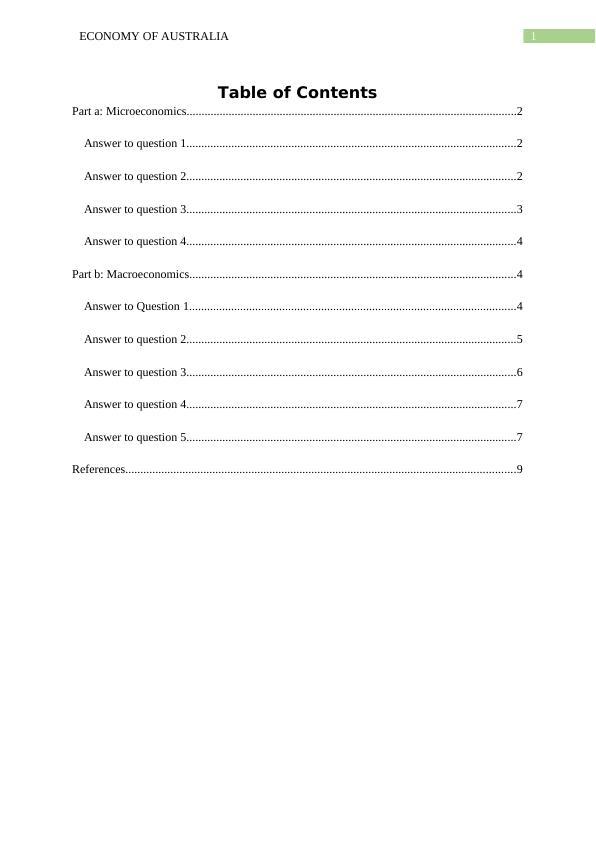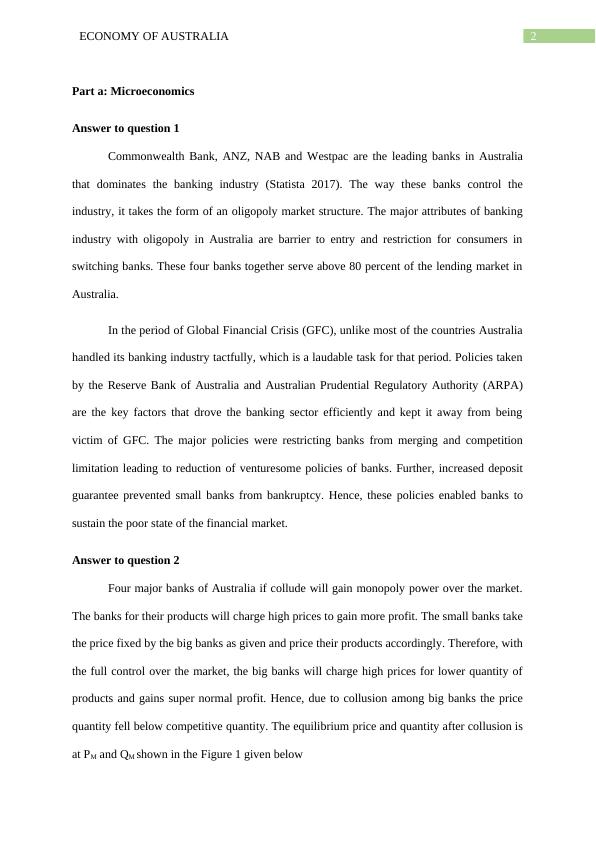Economy of Australia: Microeconomics and Macroeconomics
Added on 2023-03-23
11 Pages1589 Words48 Views
Running head: ECONOMICS
Economics
Name of the Student
Name of the University
Author Note
Economics
Name of the Student
Name of the University
Author Note

1ECONOMY OF AUSTRALIA
Table of Contents
Part a: Microeconomics..............................................................................................................2
Answer to question 1..............................................................................................................2
Answer to question 2..............................................................................................................2
Answer to question 3..............................................................................................................3
Answer to question 4..............................................................................................................4
Part b: Macroeconomics.............................................................................................................4
Answer to Question 1.............................................................................................................4
Answer to question 2..............................................................................................................5
Answer to question 3..............................................................................................................6
Answer to question 4..............................................................................................................7
Answer to question 5..............................................................................................................7
References..................................................................................................................................9
Table of Contents
Part a: Microeconomics..............................................................................................................2
Answer to question 1..............................................................................................................2
Answer to question 2..............................................................................................................2
Answer to question 3..............................................................................................................3
Answer to question 4..............................................................................................................4
Part b: Macroeconomics.............................................................................................................4
Answer to Question 1.............................................................................................................4
Answer to question 2..............................................................................................................5
Answer to question 3..............................................................................................................6
Answer to question 4..............................................................................................................7
Answer to question 5..............................................................................................................7
References..................................................................................................................................9

2ECONOMY OF AUSTRALIA
Part a: Microeconomics
Answer to question 1
Commonwealth Bank, ANZ, NAB and Westpac are the leading banks in Australia
that dominates the banking industry (Statista 2017). The way these banks control the
industry, it takes the form of an oligopoly market structure. The major attributes of banking
industry with oligopoly in Australia are barrier to entry and restriction for consumers in
switching banks. These four banks together serve above 80 percent of the lending market in
Australia.
In the period of Global Financial Crisis (GFC), unlike most of the countries Australia
handled its banking industry tactfully, which is a laudable task for that period. Policies taken
by the Reserve Bank of Australia and Australian Prudential Regulatory Authority (ARPA)
are the key factors that drove the banking sector efficiently and kept it away from being
victim of GFC. The major policies were restricting banks from merging and competition
limitation leading to reduction of venturesome policies of banks. Further, increased deposit
guarantee prevented small banks from bankruptcy. Hence, these policies enabled banks to
sustain the poor state of the financial market.
Answer to question 2
Four major banks of Australia if collude will gain monopoly power over the market.
The banks for their products will charge high prices to gain more profit. The small banks take
the price fixed by the big banks as given and price their products accordingly. Therefore, with
the full control over the market, the big banks will charge high prices for lower quantity of
products and gains super normal profit. Hence, due to collusion among big banks the price
quantity fell below competitive quantity. The equilibrium price and quantity after collusion is
at PM and QM shown in the Figure 1 given below
Part a: Microeconomics
Answer to question 1
Commonwealth Bank, ANZ, NAB and Westpac are the leading banks in Australia
that dominates the banking industry (Statista 2017). The way these banks control the
industry, it takes the form of an oligopoly market structure. The major attributes of banking
industry with oligopoly in Australia are barrier to entry and restriction for consumers in
switching banks. These four banks together serve above 80 percent of the lending market in
Australia.
In the period of Global Financial Crisis (GFC), unlike most of the countries Australia
handled its banking industry tactfully, which is a laudable task for that period. Policies taken
by the Reserve Bank of Australia and Australian Prudential Regulatory Authority (ARPA)
are the key factors that drove the banking sector efficiently and kept it away from being
victim of GFC. The major policies were restricting banks from merging and competition
limitation leading to reduction of venturesome policies of banks. Further, increased deposit
guarantee prevented small banks from bankruptcy. Hence, these policies enabled banks to
sustain the poor state of the financial market.
Answer to question 2
Four major banks of Australia if collude will gain monopoly power over the market.
The banks for their products will charge high prices to gain more profit. The small banks take
the price fixed by the big banks as given and price their products accordingly. Therefore, with
the full control over the market, the big banks will charge high prices for lower quantity of
products and gains super normal profit. Hence, due to collusion among big banks the price
quantity fell below competitive quantity. The equilibrium price and quantity after collusion is
at PM and QM shown in the Figure 1 given below

3ECONOMY OF AUSTRALIA
Figure 1: Impact of Collusion in Banking Industry in Australia
Answer to question 3
The major four banks in Australia use their market power to gain more profit by
charging high price for products. Moreover, collusion among the major banks enables them
to act as monopoly player (Telser 2017). Taking advantage of the situation the banks will
exploit the customers, charge high prices by providing less quantity of product as shown in
Figure 1, and earn supernormal profit. The small banks also face adverse consequences and
might shut down failing to compete. The government thus strive to end the possibility of
collusion by increasing and sustaining the competition to avoid loss of social welfare. As a
preventive measure, the government lowered the barriers to entry to the banking sector and
APRA formulated a new framework for licensing to permit new entrants in the industry to
operate.
Figure 1: Impact of Collusion in Banking Industry in Australia
Answer to question 3
The major four banks in Australia use their market power to gain more profit by
charging high price for products. Moreover, collusion among the major banks enables them
to act as monopoly player (Telser 2017). Taking advantage of the situation the banks will
exploit the customers, charge high prices by providing less quantity of product as shown in
Figure 1, and earn supernormal profit. The small banks also face adverse consequences and
might shut down failing to compete. The government thus strive to end the possibility of
collusion by increasing and sustaining the competition to avoid loss of social welfare. As a
preventive measure, the government lowered the barriers to entry to the banking sector and
APRA formulated a new framework for licensing to permit new entrants in the industry to
operate.

End of preview
Want to access all the pages? Upload your documents or become a member.
Related Documents
Economics: Microeconomics and Macroeconomicslg...
|11
|1491
|372
Economics: Microeconomics and Macroeconomicslg...
|12
|1714
|321
Economics: Microeconomics and Macroeconomics Study Materiallg...
|10
|1397
|415
Economics: Australian Banks and Oligopoly Marketlg...
|12
|1880
|54
Economics Assessment: Microeconomics and Macroeconomicslg...
|10
|1388
|132
Economic Principles in Finance Industrylg...
|13
|3153
|287
